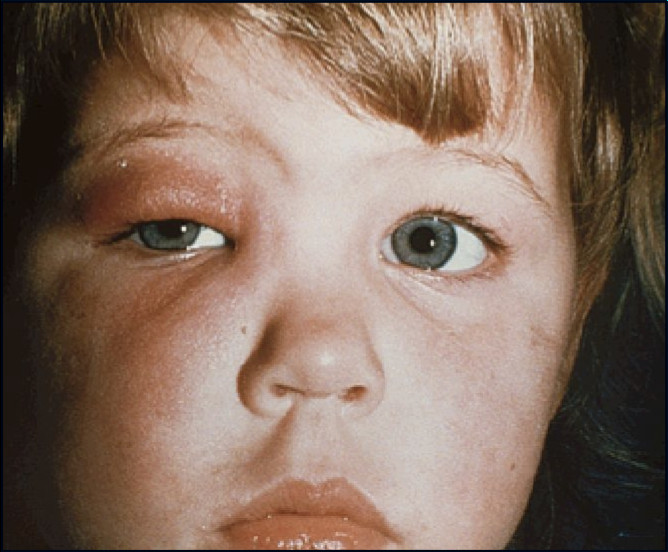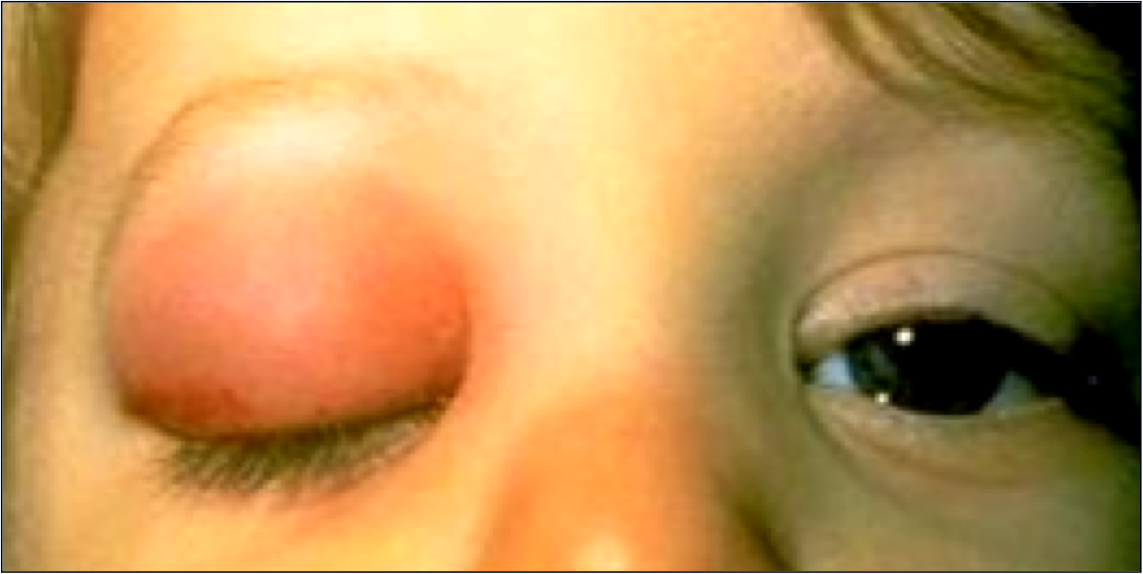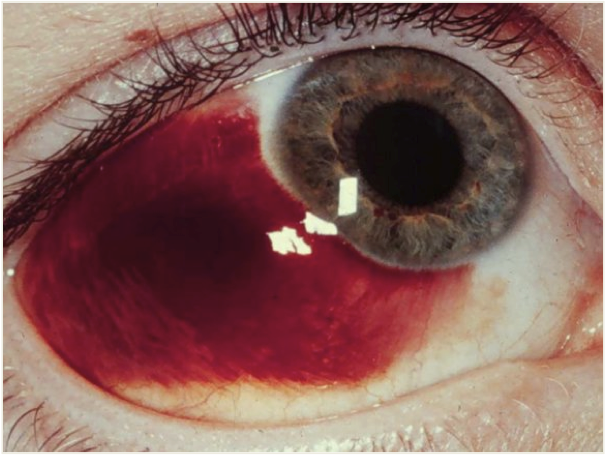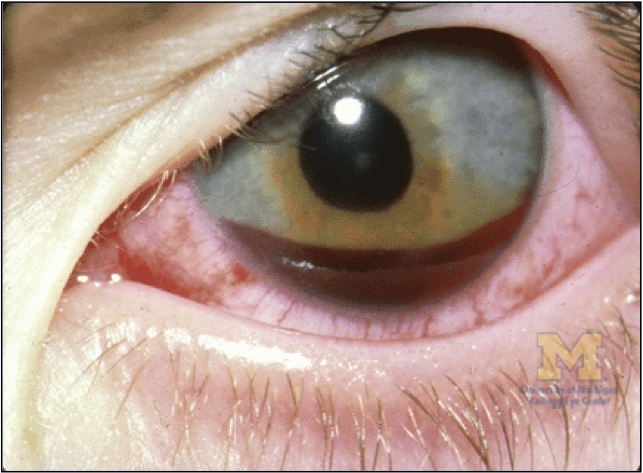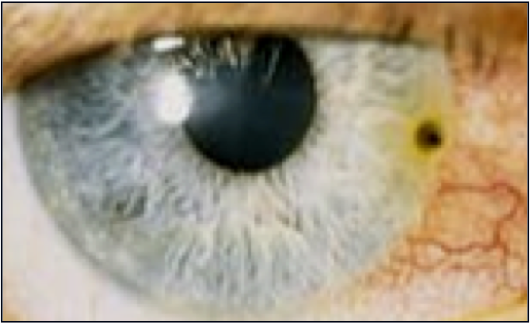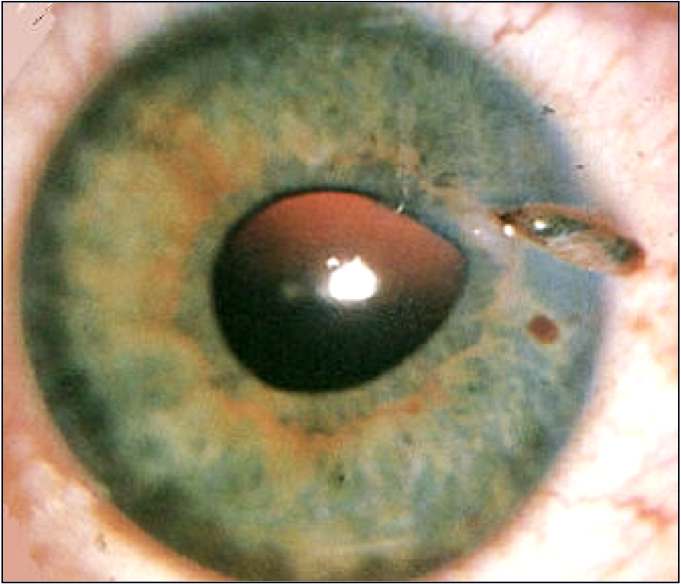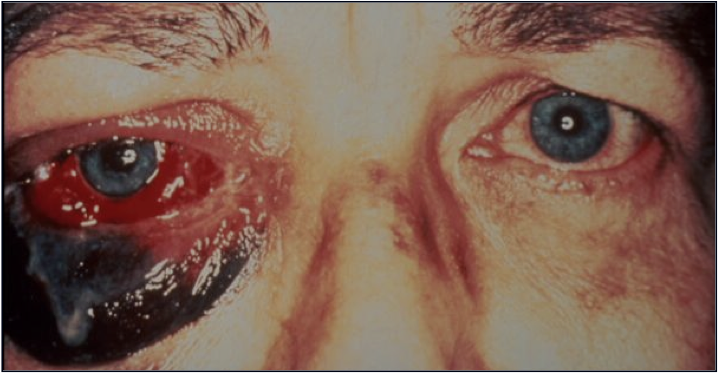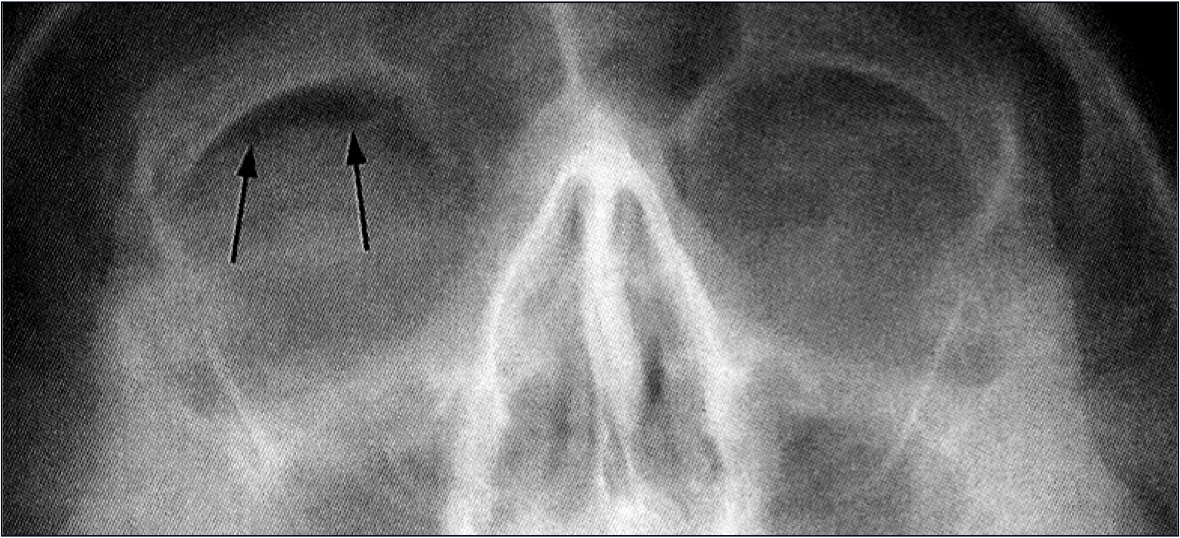Eent Quiz: Week Four

Last set of info before the big midterm :)
- 1.
Which of the following is strongly associated with demyelinating dieases such as multiple sclerosis, but can also occur with viral infections?
- A.
Optic neuritis
- B.
Papilledema
- C.
Orbital cellulitis
- D.
Ocular trauma
- E.
Ocular pearls
Correct Answer
A. Optic neuritisExplanation
Optic neuritis is strongly associated with demyelinating diseases such as multiple sclerosis, as it involves inflammation and damage to the myelin sheath surrounding the optic nerve. However, it can also occur with viral infections, as these can trigger an immune response that leads to inflammation and damage in the optic nerve. Therefore, optic neuritis can be seen in both demyelinating diseases and viral infections.Rate this question:
-
- 2.
You have a 65 year old female patient who comes in complaining of sudden, monocular loss of vision with a blind spot and loss of color vision. She has pain in her eye, particularly with eye movements, and pain on palpation of the globe. What diagnosis do you suspect?
- A.
Conjunctivitis
- B.
Papilledema
- C.
Orbital cellulitis
- D.
Ocular trauma
- E.
Ocular neuritis
Correct Answer
E. Ocular neuritisExplanation
Based on the given symptoms of sudden, monocular loss of vision with a blind spot and loss of color vision, along with pain in the eye, particularly with eye movements, and pain on palpation of the globe, the most likely diagnosis is ocular neuritis. Ocular neuritis refers to the inflammation of the optic nerve, which can cause vision loss, blind spots, and color vision impairment. The presence of pain in the eye and with eye movements further supports this diagnosis. Conjunctivitis, papilledema, orbital cellulitis, and ocular trauma do not typically present with these specific symptoms.Rate this question:
-
- 3.
Since most cases of optic neuritis are retro-bulbar, there are no abnormalities seen when examining the ____________.
- A.
Retina
- B.
Fundus
- C.
Arteries
- D.
Macula
- E.
Fovea
Correct Answer
B. FundusExplanation
Optic neuritis is inflammation of the optic nerve. Retro-bulbar optic neuritis refers to inflammation that occurs behind the eyeball. When examining the fundus, which includes the back part of the eye including the retina, optic disc, and blood vessels, no abnormalities are seen in cases of retro-bulbar optic neuritis. Therefore, the correct answer is "Fundus."Rate this question:
-
- 4.
In a more serious case of ___________________, the optic nerve is swolen with pallor, and occasionally has flame-shaped peri-papillary hemorrhages. All patients with this condition should be referred urgently for a neuro-ophthalmologic evaluation.
- A.
Conjunctivitis
- B.
Papilledema
- C.
Optic neuritis
- D.
Orbital cellulitis
- E.
Ocular trauma
Correct Answer
C. Optic neuritisExplanation
In optic neuritis, the optic nerve becomes swollen with pallor, and there may be flame-shaped peri-papillary hemorrhages. This condition requires urgent referral for a neuro-ophthalmologic evaluation because it can be a sign of an underlying neurological disorder. Optic neuritis is not the same as conjunctivitis, orbital cellulitis, or ocular trauma, which have different symptoms and causes.Rate this question:
-
- 5.
Which of the following describes a swelling of the optic nerve head, usually in association with elevated intracranial pressure and transient changes in vision?
- A.
Optic neuritis
- B.
Chronic glaucoma
- C.
Acute glaucoma
- D.
Papilledema
- E.
Orbital cellulitis
Correct Answer
D. PapilledemaExplanation
Papilledema is the correct answer because it refers to a swelling of the optic nerve head, typically caused by increased pressure within the skull. This condition is often associated with elevated intracranial pressure and can cause temporary changes in vision. Optic neuritis is inflammation of the optic nerve, chronic glaucoma is a long-term condition characterized by increased pressure within the eye, acute glaucoma is a sudden increase in eye pressure, and orbital cellulitis is an infection of the tissues surrounding the eye.Rate this question:
-
- 6.
When examining your patient with _____________, the optic disc is swollen with a blurred margin, the venules are dilated and tortuous, the optic cup is obscured by the swollen disc, there is flame hemorrhages and infarctions in the nerve fiber layer, and edema in the surrounding retina!!
- A.
Optic neuritis
- B.
Papilledema
- C.
Orbital cellulitis
- D.
Chemical conjunctivitis
- E.
Ocular trauma
Correct Answer
B. PapilledemaExplanation
Papilledema is the correct answer because it is characterized by swelling of the optic disc with a blurred margin, dilated and tortuous venules, obscured optic cup, flame hemorrhages, infarctions in the nerve fiber layer, and edema in the surrounding retina. This condition is typically caused by increased intracranial pressure, which can be due to conditions such as brain tumors, intracranial hemorrhage, or meningitis. It is important to identify papilledema as it can indicate a serious underlying condition that requires immediate medical attention.Rate this question:
-
- 7.
Papilledema is a __________ process, though it may be slightly asymmetric.
- A.
Bilateral
- B.
Unilateral
- C.
Multilateral
- D.
Multifocal
- E.
Weird
Correct Answer
A. BilateralExplanation
Papilledema is a condition characterized by swelling of the optic nerve head, which is usually caused by increased intracranial pressure. It is typically a bilateral process, meaning that it affects both eyes. Although it may be slightly asymmetric, with one eye being more affected than the other, the condition still generally involves both eyes. Therefore, the correct answer is "Bilateral."Rate this question:
-
- 8.
Which of the following describes a condition that presents with an abrupt onset of fever, proptosis (protrusion of one or both eyeballs), restriction of extraocular movements, and swelling of the redness of the lids (as shown below)?
- A.
Papilledema
- B.
Optic neuritis
- C.
Orbital cellulitis
- D.
Ocular trauma
- E.
Chemical conjunctivitis
Correct Answer
C. Orbital cellulitisExplanation
Orbital cellulitis is an infection of the tissue within the eye socket, which presents with symptoms such as fever, proptosis (bulging of the eyeballs), restriction of eye movements, and swelling and redness of the eyelids. This condition typically has an abrupt onset and can be accompanied by pain and decreased vision. It is important to promptly diagnose and treat orbital cellulitis to prevent complications such as vision loss or spread of infection to the brain.Rate this question:
-
- 9.
What is a central scotoma?
- A.
A change in peripheral vision
- B.
A lesion of the retina
- C.
A black or blind spot in vision
- D.
A symptom of papilledema
- E.
A swelling of the central portion of the optic disc
Correct Answer
C. A black or blind spot in visionExplanation
A central scotoma refers to a black or blind spot in vision. This means that there is an area in the center of the visual field where a person is unable to see clearly or at all. It can be caused by various conditions such as macular degeneration or damage to the optic nerve. This term specifically describes a loss of vision in the central part of the visual field, as opposed to peripheral vision.Rate this question:
-
- 10.
Your patient is the 6 year old daughter PA student. Her mom tells you she has just recovered from a paranasal sinus infection, but is now having eye pain, blurred vision, headache, and a purulent discharge. She has one very swollen, red eyelid, and is unable to move her eye in different directions. What is your diagnosis?
- A.
Optic neuritis
- B.
Papilledema
- C.
Ocular trauma
- D.
Conjunctivitis
- E.
Orbital cellulitis
Correct Answer
E. Orbital cellulitisExplanation
Based on the symptoms described, such as eye pain, blurred vision, headache, purulent discharge, swollen and red eyelid, and inability to move the eye, the most likely diagnosis is orbital cellulitis. Orbital cellulitis is an infection of the tissues surrounding the eye, usually caused by a bacterial infection that spreads from the paranasal sinuses. The symptoms and signs mentioned are consistent with this condition, indicating inflammation and infection in the orbital tissues. Optic neuritis is inflammation of the optic nerve, which does not explain the other symptoms. Papilledema refers to swelling of the optic nerve head, which is not mentioned in the scenario. Ocular trauma and conjunctivitis do not account for the severe symptoms and signs described.Rate this question:
-
- 11.
When diagnosing orbital cellulitis, it is important to differentiate between the different types of infections involved. _________________ infection involves only the eyelid with periorbital swelling, but no ocular symptoms. _________________ infection is suspected in the presence of proptosis, decreased VA, retinal venous engorgement, papilledema, and extraocular muscle motility disturbances. _________________ infection manifests with meningeal signs and changes in mental status.
- A.
Orbital, Intracranial, Pre-septal
- B.
Orbital, Pre-septal, Intracranial
- C.
Pre-septal, Orbital, Intracranial
- D.
Pre-septal, Intracranial, Orbital
- E.
Intracranial, Orbital, Pre-septal
Correct Answer
C. Pre-septal, Orbital, IntracranialExplanation
The question is asking for the correct order of infections involved in orbital cellulitis. Pre-septal infection involves only the eyelid with periorbital swelling, but no ocular symptoms. Orbital infection is suspected in the presence of proptosis, decreased VA, retinal venous engorgement, papilledema, and extraocular muscle motility disturbances. Intracranial infection manifests with meningeal signs and changes in mental status. Therefore, the correct order is Pre-septal, Orbital, Intracranial.Rate this question:
-
- 12.
TRUE OR FALSE?? Children who present with orbital cellulitis can be given antibiotics and sent home.
- A.
True
- B.
False
Correct Answer
B. FalseExplanation
False!! Hospitilization and immediate treatment with IV antibiotics is necessary to prevent optic nerve damage and spread of infection to the cavernous sinuses, meninges, and brain.Rate this question:
-
- 13.
Conjunctival inflammation due to chemical irritants is ______________________.
- A.
Subconjunctival hemorrhage
- B.
Chemical conjunctivitis
- C.
Hyphema
- D.
Bacterial conjunctivitis
- E.
Keratitis
Correct Answer
B. Chemical conjunctivitisExplanation
Chemical conjunctivitis refers to inflammation of the conjunctiva, which is the clear tissue that covers the white part of the eye and the inner surface of the eyelids. This inflammation occurs as a result of exposure to chemical irritants. The symptoms of chemical conjunctivitis may include redness, itching, burning, and a foreign body sensation in the eye. It is important to flush the eye with water immediately after exposure to the irritant and seek medical attention if the symptoms persist or worsen.Rate this question:
-
- 14.
The normal pH of the eye is between...
- A.
7.0 and 7.2
- B.
7.2 and 7.5
- C.
7.3 and 7.7
- D.
7.5 and 7.9
- E.
7.6 and 8.0
Correct Answer
C. 7.3 and 7.7Explanation
The normal pH of the eye is between 7.3 and 7.7. pH is a measure of acidity or alkalinity, with a pH of 7 being neutral. The slightly acidic pH range of 7.3 to 7.7 in the eye helps to maintain a healthy environment for the eye tissues and prevent the growth of harmful microorganisms. This pH range is important for the proper functioning of the eye and maintaining clear vision.Rate this question:
-
- 15.
The Morgan Lens is used for what type of procedure?
- A.
Lasik surgery
- B.
Removal of a conjunctival foreign body
- C.
Removal of a corneal foreign body
- D.
Eye irrigation with lactated Ringers' solution
- E.
Corneal abrasion treatment
Correct Answer
D. Eye irrigation with lactated Ringers' solutionExplanation
The Morgan Lens is a medical device that is specifically designed for eye irrigation with lactated Ringers' solution. This solution is used to rinse the eyes in cases of chemical burns, foreign body removal, or to flush out any irritants or contaminants. The Morgan Lens allows for continuous irrigation of the eye, ensuring thorough cleansing and promoting healing. It is a safe and effective method for eye irrigation in various medical settings.Rate this question:
-
- 16.
Which of the following is NOT an appropriate part of treatment for chemical conjunctivitis?
- A.
Remove any particulate matter
- B.
15 to 30 minutes of irrigation with lactated Ringers' solution until the pH of the eye reaches 7
- C.
Dilation of the pupil with cyclopentolate to relieve discomfort
- D.
Start prophylactic topical antibiotics
- E.
Neutralization of an acid with an alkali or vice versa
Correct Answer
E. Neutralization of an acid with an alkali or vice versaExplanation
The correct answer is "Neutralization of an acid with an alkali or vice versa." This is not an appropriate part of treatment for chemical conjunctivitis because neutralizing an acid with an alkali or vice versa can potentially cause further damage to the eye. It is important to remove any particulate matter, irrigate the eye with lactated Ringers' solution to restore the pH, dilate the pupil with cyclopentolate for relief, and start prophylactic topical antibiotics to prevent infection. However, neutralization should not be attempted as it can worsen the condition.Rate this question:
-
- 17.
TRUE OR FALSE?? Chemical conjunctivitis with acidic agents are more serious and require prolonged irrigation.
- A.
True
- B.
False
Correct Answer
B. FalseExplanation
False! Alkali injuries are worse and require more irrigation because alkalis are not precipitated by the proteins of the eyes, like the acids naturally are.Rate this question:
-
- 18.
Which of the following conditions shown below can occur even in trivial situations such as a cough, sneeze or valsalva (lol)?
- A.
Ocular trauma
- B.
Optic neuritis
- C.
Subconjunctival hemorrhage
- D.
Hyphema
- E.
Orbital cellulitis
Correct Answer
C. Subconjunctival hemorrhageExplanation
A subconjunctival hemorrhage is a condition where blood vessels in the conjunctiva, the clear membrane covering the white part of the eye, rupture and bleed. This can occur even in trivial situations such as a cough, sneeze, or valsalva maneuver (forceful exhalation with a closed mouth and nose). These actions can cause a sudden increase in pressure in the blood vessels, leading to their rupture and subsequent bleeding. Therefore, a subconjunctival hemorrhage can occur in these trivial situations.Rate this question:
-
- 19.
The blood from a subconjunctival hemorrhage, which is usually bright red and appears flat, is limited to the _______________, and stops abruptly at the ______________.
- A.
Bulbar conjunctiva, limbus
- B.
Palpebral conjunctiva, limbus
- C.
Sclera, ciliary body
- D.
Sclera, cornea
- E.
Sclera, limbus
Correct Answer
A. Bulbar conjunctiva, limbusExplanation
The blood from a subconjunctival hemorrhage is limited to the bulbar conjunctiva, which is the clear membrane that covers the white part of the eye. It appears as a bright red patch on the eye and is flat in shape. The bleeding stops abruptly at the limbus, which is the border between the cornea and the sclera (the white part of the eye).Rate this question:
-
- 20.
It is important to differentiate subconjunctival hemorrhage with bloody ____________, which can occur with scleral rupture!
- A.
Hyphema
- B.
Chemosis
- C.
Hypopyon
- D.
Acute glaucoma
- E.
Pterygium
Correct Answer
B. ChemosisExplanation
Chemosis is the correct answer because it refers to the swelling of the conjunctiva, the clear membrane that covers the white part of the eye. This swelling can cause the eye to appear red and can sometimes be mistaken for a subconjunctival hemorrhage, which is when blood collects under the conjunctiva. However, it is important to differentiate between the two because chemosis can occur with scleral rupture, which is a serious condition that requires immediate medical attention.Rate this question:
-
- 21.
TRUE OR FALSE?? Aside from the disturbing appearance, a subconjuctival hemorrhage does not usually cause the patient pain or loss of visual acuity.
- A.
True
- B.
False
Correct Answer
A. TrueExplanation
A subconjunctival hemorrhage refers to the bleeding underneath the conjunctiva, the clear tissue covering the white part of the eye. Although it may appear alarming due to the redness in the eye, it typically does not cause any pain or affect the patient's visual acuity. Therefore, the statement is true.Rate this question:
-
- 22.
If your patient has a subconjunctival hemorrhage involving the extreme lateral portion of the globe following blunt trauma, what type of fracture should be considered?
- A.
Nasal bone
- B.
Superciliary arch
- C.
Frontal bone
- D.
Zygomatic arch
- E.
Lacrimal bone
Correct Answer
D. Zygomatic archExplanation
If a patient has a subconjunctival hemorrhage involving the extreme lateral portion of the globe following blunt trauma, a fracture of the zygomatic arch should be considered. The zygomatic arch is a prominent bony structure that forms the lateral border of the eye socket. Blunt trauma to this area can cause a fracture, leading to bleeding and subsequent subconjunctival hemorrhage. The other options listed do not directly involve the lateral portion of the globe and are less likely to be associated with this specific presentation.Rate this question:
-
- 23.
Which of the following describes a condition that is the result of injury to the anterior chamber of the eye, disrupting the vasculature that supports the iris or ciliary body?
- A.
Subconjuntival hemorrhage
- B.
Hyphema
- C.
Optic neuritis
- D.
Bloody chemosis
- E.
Papilledema
Correct Answer
B. HypHemaExplanation
Hyphema is the correct answer because it refers to a condition where there is bleeding in the anterior chamber of the eye, which can disrupt the blood vessels that support the iris or ciliary body. This can occur as a result of injury to the eye. Subconjunctival hemorrhage refers to bleeding under the conjunctiva, not specifically related to the anterior chamber. Optic neuritis is inflammation of the optic nerve, not related to injury of the anterior chamber. Bloody chemosis refers to swelling and redness of the conjunctiva, not specifically related to injury of the anterior chamber. Papilledema refers to swelling of the optic disc due to increased intracranial pressure, not related to injury of the anterior chamber.Rate this question:
-
- 24.
Your patient comes in with pain, photophobia, blurred vision because of the blood, and nausea and vomiting. Based on the picture below, what is your diagnosis?
- A.
Hyphema
- B.
Blood chemosis
- C.
Subconjunctival hemorrhage
- D.
Ocular trauma
- E.
Orbital cellulitis
Correct Answer
A. HypHemaExplanation
The patient's symptoms of pain, photophobia, blurred vision, and nausea and vomiting, along with the presence of blood in the picture, suggest a diagnosis of hyphema. Hyphema refers to the accumulation of blood in the anterior chamber of the eye, which can occur due to trauma or other underlying conditions. The symptoms described are consistent with hyphema, and the presence of blood in the picture further supports this diagnosis.Rate this question:
-
- 25.
Which of the following is NOT one of the treatment recommendations for a patient presenting with hyphema?
- A.
Prevention of further hemorrhage
- B.
A fox metal eye shield
- C.
Ophthalmology consultation
- D.
Antiemetics for nausea and pain meds or sedatives
- E.
The patient should be kept supine with the head of the bed completely flat
Correct Answer
E. The patient should be kept supine with the head of the bed completely flatExplanation
The head of the bed should be slightly elevated!Rate this question:
-
- 26.
Your patient comes in complaining of "something in my eye." They have some tearing, conjunctival injection, and ciliary flush. It has been a few hours since the onset of symptoms, so they are beginning to have a headache and slight photophobia. With this information and the picture below, what is your diagnosis?
- A.
Conjunctival or Corneal foreign body
- B.
Hyphema
- C.
Subconjunctival hemorrhage
- D.
Optic neuritis
- E.
Ocular trauma
Correct Answer
A. Conjunctival or Corneal foreign bodyExplanation
Based on the patient's symptoms of tearing, conjunctival injection, ciliary flush, headache, and slight photophobia, along with the picture provided, the most likely diagnosis is a Conjunctival or Corneal foreign body. These symptoms are consistent with the presence of a foreign object in the eye, causing irritation and inflammation of the conjunctiva and potentially the cornea. The picture may show redness and swelling in the affected area, further supporting this diagnosis.Rate this question:
-
- 27.
What type of medication should be administered to a patient with a conjunctival or corneal foreign body who is complaining of headache and photophobia?
- A.
Anesthetic
- B.
Short-acting cycloplegic
- C.
Antibiotic ointment
- D.
Antibiotic drops
Correct Answer
B. Short-acting cycloplegicExplanation
A patient with a conjunctival or corneal foreign body who is complaining of headache and photophobia should be administered a short-acting cycloplegic medication. This type of medication helps to relax the muscles of the eye and reduce pain and discomfort. It can also help to dilate the pupil, which can be beneficial in cases of corneal foreign body. Anesthetic medications may provide temporary relief but do not address the underlying issue. Antibiotic ointment or drops may be necessary if there is an associated infection, but they do not specifically address the symptoms of headache and photophobia.Rate this question:
-
- 28.
When is the upper lid eversion performed?
- A.
When someone has an extremely itchy eyelid
- B.
If there is bleeding under the eyelid
- C.
If someone has ptosis
- D.
In the case of a foreign body under the upper eyelid
- E.
If the patient is unconscious
Correct Answer
D. In the case of a foreign body under the upper eyelidExplanation
Upper lid eversion is performed in the case of a foreign body under the upper eyelid. This procedure involves flipping the upper eyelid inside out to locate and remove any foreign object that may be causing irritation or discomfort. It is a common method used by healthcare professionals to address foreign body sensation or eye irritation caused by the presence of a foreign object trapped under the upper eyelid.Rate this question:
-
- 29.
What should be used to remove a foreign body from the conjunctiva or cornea?
- A.
A cotton tipped applicator coated in antibiotics
- B.
A sterile, dry cotton tipped applicator
- C.
A small pair of tweezers
- D.
A sterile, moist cotton tipped applicator
- E.
A tongue depressor
Correct Answer
D. A sterile, moist cotton tipped applicatorExplanation
A sterile, moist cotton tipped applicator should be used to remove a foreign body from the conjunctiva or cornea. Moistening the cotton tip helps to prevent further damage to the eye and provides a gentle and effective way to remove the foreign body. Sterility is important to prevent infection. Using a cotton tipped applicator coated in antibiotics or a dry cotton tipped applicator may cause discomfort or irritation to the eye. A small pair of tweezers or a tongue depressor are not appropriate tools for removing a foreign body from the eye.Rate this question:
-
- 30.
Your patient comes in and describes how he was sitting in EBM class and accidentally poked himself in the eye with the end of the paperclip. He complains of tearing, photophobia, injection, a foreign body sensation, and blepharospasm (involuntary spasm of orbicularis oculi). What is your diagnosis?
- A.
Subconjunctival hemorrhage
- B.
Conjunctival or Corneal foreign body
- C.
Hyphema
- D.
Corneal abrasion
- E.
Corneal ulcer
Correct Answer
D. Corneal abrasionExplanation
Based on the patient's symptoms of tearing, photophobia, injection, foreign body sensation, and blepharospasm, the most likely diagnosis is a corneal abrasion. A corneal abrasion is a scratch or injury to the cornea, which is the clear front surface of the eye. The accidental poke with the paperclip could have caused a scratch on the cornea, leading to the symptoms described by the patient. Subconjunctival hemorrhage, conjunctival or corneal foreign body, hyphema, and corneal ulcer are less likely diagnoses based on the given symptoms.Rate this question:
-
- 31.
When someone has a foreign body stuck to their upper eyelid, it can abrade the cornea, causing an ____________ sign that can be seen under fluorescein staining as shown below.
- A.
Pencil scratch
- B.
Cat-scratch
- C.
Scribble
- D.
Ice-rink
- E.
Scratchy
Correct Answer
D. Ice-rinkExplanation
When a foreign body is stuck to the upper eyelid, it can cause abrasion on the cornea. This abrasion appears as a pattern similar to the surface of an ice-rink when viewed under fluorescein staining. The term "ice-rink" is used to describe this specific pattern of corneal abrasion.Rate this question:
-
- 32.
TRUE OR FALSE?? Topical anesthetic drops are good to use in the office for a patient with a corneal abrasion to perform a better examination and relieve pain, but should not be sent home with the patient because they inhibit healing.
- A.
True
- B.
False
Correct Answer
A. TrueExplanation
Using topical anesthetic drops in the office for a patient with a corneal abrasion can be beneficial as they help in performing a more thorough examination and provide pain relief. However, these drops should not be sent home with the patient because they can inhibit the healing process.Rate this question:
-
- 33.
Which type of test can be done to confirm the diagnosis of corneal abrasion?
- A.
X-ray
- B.
Morgan lens test
- C.
Corneal reflex
- D.
Fluorescien staining
- E.
Magic color-changing eyedrops
Correct Answer
D. Fluorescien stainingExplanation
Fluorescein staining is a type of test that can be done to confirm the diagnosis of corneal abrasion. This test involves placing a few drops of fluorescein dye onto the surface of the eye. The dye highlights any damage or irregularities on the cornea, making it easier for the healthcare provider to visualize and diagnose a corneal abrasion. It is a commonly used and effective method for diagnosing this condition.Rate this question:
-
- 34.
What type of prophylaxis is recommended for a patient recovering from a corneal abrasion?
- A.
Antifungal
- B.
Antibiotic
- C.
Tetanus
- D.
Hepatitis
- E.
Analgesic
Correct Answer
C. TetanusExplanation
Tetanus prophylaxis is recommended for a patient recovering from a corneal abrasion because corneal abrasions can be caused by foreign objects, and tetanus is a bacterial infection that can occur when bacteria enters the body through a wound. Tetanus prophylaxis helps prevent the development of tetanus infection.Rate this question:
-
- 35.
When should a patient recovering from a corneal abrasion be expected to follow-up with you?
- A.
1-2 days
- B.
3-4 days
- C.
1 week
- D.
2 weeks
- E.
Only if still symptomatic
Correct Answer
A. 1-2 daysExplanation
After a patient has suffered from a corneal abrasion, it is important for them to follow up with the healthcare provider within 1-2 days. This is because corneal abrasions can lead to complications such as infection or delayed healing, and early intervention is crucial to prevent any further damage or complications. By scheduling a follow-up appointment within this timeframe, the healthcare provider can assess the patient's progress, monitor for any signs of infection or complications, and adjust the treatment plan if necessary.Rate this question:
-
- 36.
Which of the following conditions is also knows as diffuse punctuate keratopathy and "welder's flash," and can be caused by ultraviolet burns of the cornea, typically from using a sunlamp without protection, exposure to a welding arc, or exposure to the sun when skiing ("snow blindness")?
- A.
Perforated globe
- B.
Ultraviolet keratitis
- C.
Hyphema
- D.
Corneal ulcer
- E.
Orbital cellulitis
Correct Answer
B. Ultraviolet keratitisExplanation
Ultraviolet keratitis is a condition that is also known as diffuse punctuate keratopathy and "welder's flash." It can be caused by ultraviolet burns of the cornea, typically from using a sunlamp without protection, exposure to a welding arc, or exposure to the sun when skiing ("snow blindness"). This condition is characterized by inflammation and damage to the cornea due to excessive exposure to ultraviolet radiation. Symptoms may include pain, redness, tearing, blurred vision, and sensitivity to light. Treatment usually involves the use of lubricating eye drops, pain medications, and avoiding further exposure to ultraviolet radiation.Rate this question:
-
- 37.
You decide to do a fluorescein stain on a patient who you suspect has ultraviolet keratits. The stain reveals multiple little pinpoint areas of dye uptake. What is this due to?
- A.
Ruptured conjunctival pockets of fluid
- B.
Shattered pupillary cells
- C.
Ruptured corneal epithelial cells
- D.
Reflection of the back of the retina
- E.
Particles in the vitreous
Correct Answer
C. Ruptured corneal epithelial cellsExplanation
The correct answer is ruptured corneal epithelial cells. When performing a fluorescein stain, the dye is applied to the eye's surface. In the case of ultraviolet keratitis, the corneal epithelial cells may become damaged or ruptured due to exposure to ultraviolet radiation. The dye uptake in multiple little pinpoint areas indicates the presence of these ruptured corneal epithelial cells, which can help confirm the diagnosis of ultraviolet keratitis.Rate this question:
-
- 38.
When fluroescein stain streams away from what you suspect to be a corneal abrasion (Seidel's test), this may be an indication of what other condition?
- A.
Corneal ulcer
- B.
Corneal perforation
- C.
Ultraviolet keratitis
- D.
Ocular trauma
- E.
Papilledema
Correct Answer
B. Corneal perforationExplanation
When fluorescein stain streams away from what is suspected to be a corneal abrasion, it indicates a corneal perforation. A corneal perforation refers to a hole or rupture in the cornea, which is the clear front surface of the eye. This condition can be serious and requires immediate medical attention. The streaming of fluorescein stain suggests that the fluid is leaking out of the cornea through the perforation, confirming the presence of a corneal perforation.Rate this question:
-
- 39.
TRUE OR FALSE?? There are no immediate symptoms of Ultraviolet Keratitis, but within 24-48 hours, the patient will complain of agonizing pain and severe photophobia.
- A.
True
- B.
False
Correct Answer
B. FalseExplanation
The patient will complain of symptoms about 6 to 12 HOURS after exposure, and the patient should be recovered within 24-48 hours without complications!Rate this question:
-
- 40.
TRUE OR FALSE?? A perforated globe injury is a result of penetrating trauma, can be subtle and easily overlooked, and are all considered serious injuries.
- A.
True
- B.
False
Correct Answer
A. TrueExplanation
A perforated globe injury refers to a rupture or hole in the eyeball caused by penetrating trauma. These injuries can be subtle and easily overlooked because they may not always present with obvious external signs. However, they are considered serious because they can lead to severe vision loss or even loss of the eye itself. Therefore, the statement is true.Rate this question:
-
- 41.
You have a patient who comes in and tells you they were poked in the eye by a marshmallow stick while camping. Her mom always said to not play with them because someone's eye could get poked out! She presents with a teardrop shaped pupil that points in the direction of the area of penetration. You examine her and note a loss of anterior chamber depth due to leakage of the aqueous humor and a slight prolapse of choroid through the wound. What is your diagnosis?
- A.
Corneal abrasion
- B.
Corneal perforation
- C.
Perforated globe
- D.
Corneal ulcer
- E.
Conjunctival or corneal foreign body
Correct Answer
C. Perforated globeExplanation
The correct answer is "Perforated globe." Based on the patient's history of being poked in the eye with a sharp object, the presence of a teardrop-shaped pupil that points towards the area of penetration, and the findings of a loss of anterior chamber depth and prolapse of choroid through the wound, it is likely that the globe (eyeball) has been perforated. This is a serious condition that requires immediate medical attention to prevent further damage and potential loss of vision.Rate this question:
-
- 42.
TRUE OR FALSE?? If you have a patient with a perforated globe, every effort should be made to examine, measure pressure, and manipulate the eye to make the correct diagnosis and treatment plan.
- A.
True
- B.
False
Correct Answer
B. FalseExplanation
False!! NO attempts should be made to do ANY of these things!!Rate this question:
-
- 43.
Which of the following is NOT recommended as one of the treatment options for a patient diagnosed with a perforated globe?
- A.
Flush the eye out with sterile saline.
- B.
Sedation and aggressive pain meds to prevent expulsion of intraocular contents due to crying, vomiting, or any activity.
- C.
Update tetanus immunization.
- D.
Bandage lightly and place a Fox metal eye shield over the eye.
- E.
IV antibiotics to cover gram-positive organisms.
Correct Answer
A. Flush the eye out with sterile saline. -
- 44.
A patient comes in and tells you that they were building a deck this weekend and while hammering in some nails, felt like "something hit him in the eye." No corneal foreign body is visible, but the patient is complaining of visual loss and you note an apparent cornea/sclera wound and some opacity. What is your diagnosis?
- A.
Perforated globe
- B.
Conjunctival or corneal foreign body
- C.
Intraocular foreign body
- D.
Corneal abrasion
- E.
Corneal ulcer
Correct Answer
C. Intraocular foreign bodyExplanation
The patient's complaint of visual loss, along with the apparent cornea/sclera wound and opacity, suggests that there is an object inside the eye, causing damage and visual impairment. This indicates an intraocular foreign body, which refers to any object that has entered the eye and is lodged inside the eye. It is important to identify and remove the foreign body promptly to prevent further damage and complications.Rate this question:
-
- 45.
What diagnostic test is contraindicated for scanning and identifying an intraocular foreign body?
- A.
Xray
- B.
CT
- C.
MRI
- D.
Staining
- E.
Funduscopic exam
Correct Answer
C. MRIExplanation
In case they have a fragment of metal in their eye, you risk moving the object and causing further damage with the magnetic field of the MRI :)Rate this question:
-
- 46.
Which of the following is the result of a direct compressive force to the globe of the eye (Such as being hit by a baseball)?
- A.
Corneal perforation
- B.
Corneal rupture
- C.
Intraocular foreign body
- D.
Blow-out fracture
- E.
Perforated globe
Correct Answer
D. Blow-out fractureExplanation
A blow-out fracture is the result of a direct compressive force to the globe of the eye, such as being hit by a baseball. This occurs when the force causes a fracture in the bones surrounding the eye, typically the orbital floor or the medial wall of the orbit. The fracture creates a defect through which the orbital contents, including the eye, can herniate into the surrounding sinuses or tissues. This can lead to double vision, restricted eye movement, and other symptoms. Therefore, a blow-out fracture is the correct answer in this case.Rate this question:
-
- 47.
You have a patient come in after being hit in the face with a softball during a company picnic. He presents with binocular diplopia, restricted eye movement, decreased sensation over hte inferior orbital rim, and enophthalmos (posterior displacement of the globe). His picture is shown below. What is your diagnosis?
- A.
Subconjunctival hemorrhage
- B.
Blow-out fracture
- C.
Perforated globe
- D.
Hyphema
- E.
Bloody chemosis
Correct Answer
B. Blow-out fractureExplanation
The patient's symptoms of binocular diplopia, restricted eye movement, decreased sensation over the inferior orbital rim, and enophthalmos are all indicative of a blow-out fracture. This type of fracture occurs when there is a fracture of the orbital floor or medial wall, causing the orbital contents to be displaced. The picture shown also supports this diagnosis as it demonstrates the enophthalmos and possible swelling. A blow-out fracture can be caused by a direct blow to the face, such as being hit by a softball, and can result in double vision, restricted eye movement, and other associated symptoms.Rate this question:
-
- 48.
When a patient presents with a blow-out fracture, and they have restricted eye movement especially in the upward gaze, the entrapment of what extraocular eye muscle is suspected? (PS: if you suspect this type of entrapment, you should order a CT scan!)
- A.
Superior rectus
- B.
Inferior rectus
- C.
Lateral rectus
- D.
Medial rectus
- E.
Superior oblique
Correct Answer
B. Inferior rectusExplanation
When a patient presents with a blow-out fracture and has restricted eye movement, especially in the upward gaze, the entrapment of the inferior rectus muscle is suspected. The blow-out fracture can cause the inferior rectus muscle to become entrapped, leading to its dysfunction and restricted eye movement. To confirm this suspicion, a CT scan should be ordered to visualize the fracture and assess any entrapment.Rate this question:
-
- 49.
In what condition does the Waters and Caldwell plain x-ray films show a radiographic finding described as an "opaque teardrop hanging from the roof of the antrum," which is due to the herniation of some of the orbital contents downwards through the orbital floor?
- A.
Intraocular foreign body
- B.
Blow-out fracture
- C.
Corneal abrasion
- D.
Conjunctival or corneal foreign body
- E.
Perforated globe
Correct Answer
B. Blow-out fractureExplanation
A blow-out fracture refers to a fracture of the bones surrounding the eye, typically the orbital floor, which results in the herniation of orbital contents downwards. This can cause an "opaque teardrop hanging from the roof of the antrum" appearance on Waters and Caldwell plain x-ray films. Intraocular foreign body, corneal abrasion, conjunctival or corneal foreign body, and perforated globe are not associated with this specific radiographic finding.Rate this question:
-
- 50.
An x-ray that shows an air pocket called a "black-eyebrow sign," is due to a blow-out fracture through the wall of either of two sinuses where there is air entering the orbit. What two sinuses are most commonly involved in this finding?
- A.
Ethmoid or frontal
- B.
Frontal or lacrimal
- C.
Maxillary or frontal
- D.
Maxillary or ethmoid
- E.
Mandibular or ethmoid
Correct Answer
D. Maxillary or ethmoidExplanation
The "black-eyebrow sign" is a term used to describe an air pocket seen on an x-ray due to a blow-out fracture. This fracture occurs through the wall of either the maxillary or ethmoid sinuses, where air enters the orbit. Therefore, the most commonly involved sinuses in this finding are the maxillary or ethmoid sinuses.Rate this question:
-
Quiz Review Timeline +
Our quizzes are rigorously reviewed, monitored and continuously updated by our expert board to maintain accuracy, relevance, and timeliness.
-
Current Version
-
Feb 03, 2023Quiz Edited by
ProProfs Editorial Team -
Sep 23, 2009Quiz Created by
Saraholson7



